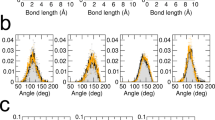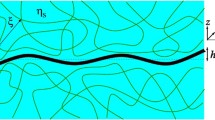Abstract
The lattice Boltzmann cellular automaton method has been successfully extended for analysis of fluid interactions with a deformable membrane or web. The hydrodynamic forces on the solid web are obtained through computation of the fluid flow stress at the moving boundary using the lattice Boltzmann method. Analysis of solid boundary deformation or vibration due to hydrodynamic force is based on Newtonian dynamics and a molecular dynamic type approach.
Similar content being viewed by others
REFERENCES
Y. B. Chang, P. M. Moretti, Tappi March, 231, (1991).
Y. B. Chang, P. M. Moretti, Sheet Flutter & Windage Problems Seminar. Tappi notes, 14 (1991). Web Handling, ASME 67 (1992).
Y. B. Chang, “An Experimental and Analytical Study of Web Flutter,” Ph.D. Dissertation, School of Mechanical and Aerospace Engineering, Oklahoma State University, Stillwater (1990).
A. J. C. Ladd, J. Fluid Mech., “Numerical simulations of particulate suspensions via a discretized Boltzmann equation, Part I,” 271:285 (1994).
A. J. C. Ladd, J. Fluid Mech., “Numerical simulations of particulate suspensions via a discretized Boltzmann equation, Part II,” 271:311 (1994).
U. Frisch, B. Hasslacher, and Y. Poemeau, Phys. Rev. Lett., “Lattice-Gas Automaton for the Navier Stokes Equation,” 56:1505 (1986).
S. Wolfram, J. Stat. Phys., “Cellular Automaton Fluids 1: Basic Theory,” 45:471 (1986).
G. McNamara, and G. Zanetti, Phys. Rev. Lett., “Use of the Boltzmann Equation to Simulate Lattice-Gas Automaton,” 61:2332 (1988).
P. Bhatnagar, E. P. Gross, and M. K. Krook, Phys. Rev., “A Model for Collision Processes in Gas: I, Small amplitude Processes in Charged and Neutral One-Component Systems,” 94:511 (1954).
Shuling Hou, Qisu Zou, Shixi Chen, Gary D. Doolen and A. Cogley, “Simulation of Incompressible Navier-Stokes Fluid Flows Using a Lattice Boltzmann Method” J. Computational Physics 118:329 (1993).
C. K. Aidun and Y. Lu, “Lattice Boltzmann Simulation of Solid Suspensions with Impermeable Boundaries” J. Statistical Physics 81:(no. 1/2), 49, (1995).
C. K. Aidun, Y. Lu, and E.-J. Ding, “Dynamic Simulation of Particules Suspended in Fluid,” Proc. of the 6th International Symp. on Solid-Liquid Flows, FEDSM/ASME, Vancouver, Canada, June 22, 1997.
H. L. Dryden, F. P. Murnaghan, and H. Bateman, Hydro-dynamics (1956).
D. H. Heermann, Computer Simulation Methods in Theoretical Physics, Springer-Verlag Berlin Heidelberg New York (1986).
R. W. Hockney, Methods Comput. Phys. 9:136 (1970), P. Potter, Computational Physics, Wiley, New York, Verlet, L. Phys. Rev. 165:201 (1968), 159:98 (1967).
M. Poliashenko and C. K. Aidun, “Computational Dynamics of Ordinary Differential Equations,” International J. Bifurcation and Chaos 5:1 (1995).
Author information
Authors and Affiliations
Rights and permissions
About this article
Cite this article
Aidun, C.K., Qi, D.W. A New Method for Analysis of the Fluid Interaction with a Deformable Membrane. Journal of Statistical Physics 90, 145–158 (1998). https://doi.org/10.1023/A:1023299617476
Issue Date:
DOI: https://doi.org/10.1023/A:1023299617476




